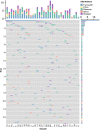Identification of potential susceptibility genes in patients with primary Sjögren's syndrome-associated pulmonary arterial hypertension through whole exome sequencing
- PMID: 37730603
- PMCID: PMC10510152
- DOI: 10.1186/s13075-023-03171-y
Identification of potential susceptibility genes in patients with primary Sjögren's syndrome-associated pulmonary arterial hypertension through whole exome sequencing
Abstract
Background: Pulmonary arterial hypertension (PAH) is a rare complication of primary Sjögren's syndrome (pSS). Several genes have proven to be associated with pSS and PAH. However, there is no study specifically addressing the genetic susceptibility in pSS combined with PAH.
Methods: Thirty-four unrelated patients with pSS-PAH were recruited from April 2019 to July 2021 at Peking Union Medical College Hospital. Demographic and clinical data were recorded in detail, and peripheral blood samples were collected for whole-exome sequencing (WES). Gene ontology (GO) and Kyoto Encyclopedia of Genes and Genomes (KEGG) pathway analysis were performed to predict the functional effect of mutant genes. Genetic variants identified by WES were confirmed by polymerase chain reaction (PCR)-Sanger sequencing.
Results: We totally identified 141 pathogenic variant loci of 129 genes in these 34 pSS-PAH patients, using WES analysis. Patients with a family history of rheumatic diseases are more likely to carry FLG mutations or carry gene variations related to the biosynthesis of the amino acids pathway (p < 0.05). According to Sanger sequencing confirmation and pathogenicity validation, we totally identified five candidate pathogenic variants including FLG c.12064A > T, BCR c.3275_3278dupCCGG, GIGYF2 c.3463C > A, ITK c.1741C > T, and SLC26A4 c.919-2A > G.
Conclusion: Our findings provide preliminary data of exome sequencing to identify susceptibility loci for pSS-PAH and enriched our understanding of the genetic etiology for pSS-PAH. The candidate pathogenic genes may be the potential genetic markers for early warning of this disease.
Keywords: BCR; FLG; GIGYF2; ITK; Primary Sjögren’s syndrome; Pulmonary arterial hypertension; SLC26A4; Whole-exome sequencing.
© 2023. BioMed Central Ltd., part of Springer Nature.
Conflict of interest statement
The authors declare no competing interests.
Figures




Similar articles
-
The prognosis of pulmonary arterial hypertension associated with primary Sjögren's syndrome: a cohort study.Lupus. 2018 Jun;27(7):1072-1080. doi: 10.1177/0961203318756287. Epub 2018 Feb 8. Lupus. 2018. PMID: 29419347
-
Characteristics and risk factors for pulmonary arterial hypertension associated with primary Sjögren's syndrome: 15 new cases from a single center.Int J Rheum Dis. 2019 Sep;22(9):1775-1781. doi: 10.1111/1756-185X.13671. Epub 2019 Jul 31. Int J Rheum Dis. 2019. PMID: 31368254
-
Clinical characteristics and risk factors for primary Sjögren's syndrome complicated with pulmonary arterial hypertension.Zhong Nan Da Xue Xue Bao Yi Xue Ban. 2023 Mar 28;48(3):339-346. doi: 10.11817/j.issn.1672-7347.2023.220618. Zhong Nan Da Xue Xue Bao Yi Xue Ban. 2023. PMID: 37164917 Free PMC article. Chinese, English.
-
Pulmonary arterial hypertension: a rare complication of primary Sjögren syndrome: report of 9 new cases and review of the literature.Medicine (Baltimore). 2007 Sep;86(5):299-315. doi: 10.1097/MD.0b013e3181579781. Medicine (Baltimore). 2007. PMID: 17873760 Review.
-
Description of Two New Cases of AQP1 Related Pulmonary Arterial Hypertension and Review of the Literature.Genes (Basel). 2022 May 22;13(5):927. doi: 10.3390/genes13050927. Genes (Basel). 2022. PMID: 35627312 Free PMC article. Review.
Cited by
-
Exploring the Genetic Association Between Connective Tissue Diseases and the Risk of Pulmonary Arterial Hypertension: A Mendelian Randomization Analysis.Pulm Circ. 2024 Dec 24;14(4):e70033. doi: 10.1002/pul2.70033. eCollection 2024 Oct. Pulm Circ. 2024. PMID: 39720342 Free PMC article.
-
Molecular Pathogenesis of Connective Tissue Disease-Associated Pulmonary Arterial Hypertension: A Narrative Review.Biomolecules. 2025 May 27;15(6):772. doi: 10.3390/biom15060772. Biomolecules. 2025. PMID: 40563413 Free PMC article. Review.
-
Risk Factors for Adverse Outcomes in Connective Tissue Disease-Associated Pulmonary Hypertension.Rev Cardiovasc Med. 2025 Mar 17;26(3):26877. doi: 10.31083/RCM26877. eCollection 2025 Mar. Rev Cardiovasc Med. 2025. PMID: 40160570 Free PMC article. Review.
References
-
- Fox RI. Sjögren's syndrome. Lancet. 2005;366(9482):321–331. - PubMed
-
- Zhao J, Wang Q, Liu Y, Tian Z, Guo X, Wang H, et al. Clinical characteristics and survival of pulmonary arterial hypertension associated with three major connective tissue diseases: A cohort study in China. Int J Cardiol. 2017;236:432–437. - PubMed
-
- Simonneau G, Gatzoulis MA, Adatia I, Celermajer D, Denton C, Ghofrani A, et al. Updated clinical classification of pulmonary hypertension. J Am Coll Cardiol. 2013;62(25 Suppl):D34–41. - PubMed
-
- Wang J, Li M, Wang Q, Zhang X, Qian J, Zhao J, et al. Pulmonary arterial hypertension associated with primary Sjögren's syndrome: a multicentre cohort study from China. Eur Respir J. 2020;56(5):1902157. - PubMed
Publication types
MeSH terms
Substances
LinkOut - more resources
Full Text Sources
Medical
Miscellaneous

